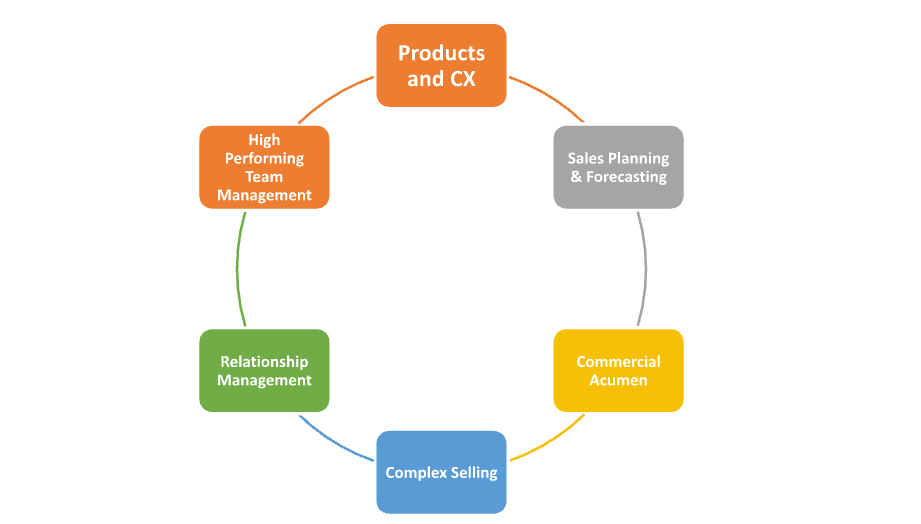Businesses often struggle with ineffective Go-To-Market strategies, even with unique products and services. The critical nexus between sales and marketing, and the alignment of desired GTM with actual implementation, hinges on leveraging technology effectively.
A people-centric sales and marketing framework is the foundation for unlocking growth. Especially at the intersection of sales and marketing efforts.

Sales competency and performance optimization
Embarking on the journey towards growth requires a competency and skills grid meticulously mapped to unique roles. This grid becomes the cornerstone for assessing sales competency levels. It paves the way for a tailored learning and development roadmap for each sales professional and leader. Clearly defined Marketing intersections include Products & Customer Experience (CX), Complex Selling, and Relationship Management.

End-to-end buyer insights
In the pursuit of buyer personas and precise buyer insights, sales teams necessitate a comprehensive approach. Integration of social listening tools and persona research books is essential to tap into the vast digital footprints available. Mining digital footprints allows for the determination of precise CXO buyer sentiment, thereby enhancing customer conversations.
Expand social listening to cover targeted buyers across online and social platforms. Couple this with the potential creation of a dedicated platform. You can then address the challenge of finding the right buyer at the right event.
Content distribution excellence (social advocacy)
The ability to create content at scale is only as effective as its distribution. Platforms should focus not only on enabling easy content consumption but also on facilitating seamless distribution. This extends beyond private contexts to include viral distribution through social advocacy. Adopting a gamified approach, such as ranking boards and Social Selling indices, transforms social advocacy into a balanced "What's In It For Me" (WIFM) solution for sales and marketing.

The R-R-R marketing approach
An integrated sales and marketing calendar proves to be a desirable antidote to the traditional friction between these two teams. The RRR approach – Revenues, Relationships, and Reputation – promotes collaboration and can be further enhanced by a deeply integrated sales platform for efficiency.
At the core of the RRR approach lies a commitment to ROI-driven Marketing, spanning across diverse markets. This strategic focus aims to construct a robust brand presence and foster enduring relationships with customers. The primary objectives include generating demand, ensuring high-quality sales conversion, and propelling revenue growth within targeted markets. This approach forms the bedrock for sustainable business success, aligning marketing efforts with tangible returns on investment.
Going beyond with B2B sales and marketing
Building lasting relationships with customers and the C-Suite is the enduring part of the RRR approach. C-level engagements can be modeled on three spaces – Passion, Knowledge, and Care.
Knowledge engagements: Innovation workshops and Advisory Boards tailored to the business purpose of customers and their industry are high-touch vehicles to build credibility and forge relationships.
Passion engagements: Beyond their demanding professional side, C-level executives have a playful, passion-filled, and skill-based dimension. Examples include corporate golf and weekend Masterchef hangouts with the C-suite and their spouses, contributing to deepening relationships on and off the course.
Care: The C-suite often has a deepened sense of giving back to the community. Corporate ESG and CSR programs or personal associations are ways to achieve this purpose. As partners to your customers, identify a common purpose for such engagements. Notable examples include Environment Day programs engaging EV units and companies in a social pledge through activities like the ice bucket challenge, involving senior leaders on both sides.
The foundation of these high-touch engagements needs to be a robust Account-Based Program, tying various engagements to fuel the relationship and sales funnel. Customer Advocacy emerges as a powerful source of brand advocacy.
In essence, the adage "Sales is the Marketing, and Marketing is the Sales" encapsulates the key to unlocking growth. Facilitating collaboration between these two crucial business functions through technology is the linchpin for sustained success in the B2B arena.
FAQs
Q: What is sales and marketing integration?
A: Sales and marketing integration refers to the alignment and collaboration between these two crucial business functions. It serves as the foundation for unlocking growth, especially at the intersection of sales and marketing efforts.
At the core lies a people-centric framework that encompasses sales competency optimization, end-to-end buyer insights, content distribution excellence through social advocacy, and an integrated sales and marketing calendar following the R-R-R approach.
The R-R-R approach - Revenues, Relationships, and Reputation - promotes collaboration between sales and marketing teams. It focuses on RoI-driven marketing spanning diverse markets to construct a robust brand presence, foster enduring customer relationships, generate demand, ensure high-quality sales conversion, and propel revenue growth.
Integration goes beyond traditional boundaries by building lasting relationships with customers and the C-Suite through high-touch engagements like innovation workshops, advisory boards, corporate events catering to their passions, and corporate social responsibility programs aligned with common purposes.
Account-Based Programs should involve various engagements to fuel the relationship and sales funnel. Customer advocacy then emerges as a powerful source of brand advocacy.
In essence, facilitating collaboration between sales and marketing through technology is the linchpin for sustained success in the B2B arena, encapsulating the adage "Sales is the Marketing, and Marketing is the Sales."
Q: How does marketing help B2B sales?
A: Marketing plays a pivotal role in supporting and fueling B2B sales success through an integrated approach. The RRR marketing framework - focusing on Revenues, Relationships, and Reputation - is instrumental in aligning marketing efforts with tangible business outcomes.
At its core, RoI-driven marketing spanning diverse markets constructs a robust brand presence, which is foundational for demand generation and high-quality sales conversion. By cultivating enduring relationships with customers, marketing efforts pave the way for sustained revenue growth within targeted markets.
Beyond traditional demand generation, marketing supports sales through comprehensive buyer insights derived from social listening tools, persona research, and mining digital footprints. This allows for the precise determination of CXO buyer sentiment, enabling more impactful customer conversations.
Content excellence, fueled by effortless distribution and amplified by social advocacy, is another crucial element. Platforms that facilitate seamless content consumption and viral distribution, augmented by gamification tactics like ranking boards and social selling indices, create a balanced "What's In It For Me" proposition aligning sales and marketing motivations.
Ultimately, an integrated sales and marketing calendar serves as an antidote to traditional friction, promoting collaboration. This synergy is further enhanced by deeply integrated sales platforms that drive efficiency.
In essence, marketing's foundation of RoI accountability, coupled with its ability to foster relationships, shape reputations, and generate insights, serves as a powerful catalyst for sales success in the B2B domain.
Q: How do I start sales and marketing integration?
A: Starting your journey towards sales and marketing integration begins with establishing a solid foundation - a people-centric framework that brings these two functions together.
The first step is to embark on a competency mapping exercise, meticulously outlining a skills grid aligned with the unique roles within your sales organization. This competency grid will serve as the cornerstone for assessing the current proficiency levels of your sales professionals and leaders. It will pave the way for a tailored learning and development roadmap that optimizes sales performance.
In parallel, you must adopt a comprehensive approach to derive end-to-end buyer insights. Integrate social listening tools and leverage persona research to tap into the vast digital footprints of your target buyers. This will allow you to precisely determine CXO sentiment, enabling more impactful customer conversations. Consider expanding your social listening efforts and potentially creating a dedicated platform to ensure you find the right buyers at the right events.
Next, focus on achieving content distribution excellence through social advocacy. While content creation at scale is crucial, its effectiveness hinges on seamless distribution. Implement platforms that not only facilitate easy content consumption but also viral distribution amplified by social advocacy. Embrace gamification tactics like leaderboards and social selling indices to transform advocacy into a balanced value proposition for both sales and marketing teams.
Lay the groundwork for an integrated sales and marketing calendar based on the RRR approach - Revenues, Relationships, and Reputation. This integrated calendar will serve as an antidote to traditional friction, fostering collaboration that can be further enhanced by deeply integrated sales platforms driving efficiency.
Ultimately, the key is to leverage technology as the linchpin to facilitate collaboration between these two critical functions. Start with these foundational elements, continually refine your approach, and you'll be well on your way to unlocking sustainable growth through integrated sales and marketing.
Integrating sales and marketing is a top topic of conversation on the CMO Alliance Community Slack channel. Discover more advice from top marketing leaders around the world.
And it's completely free to join.




